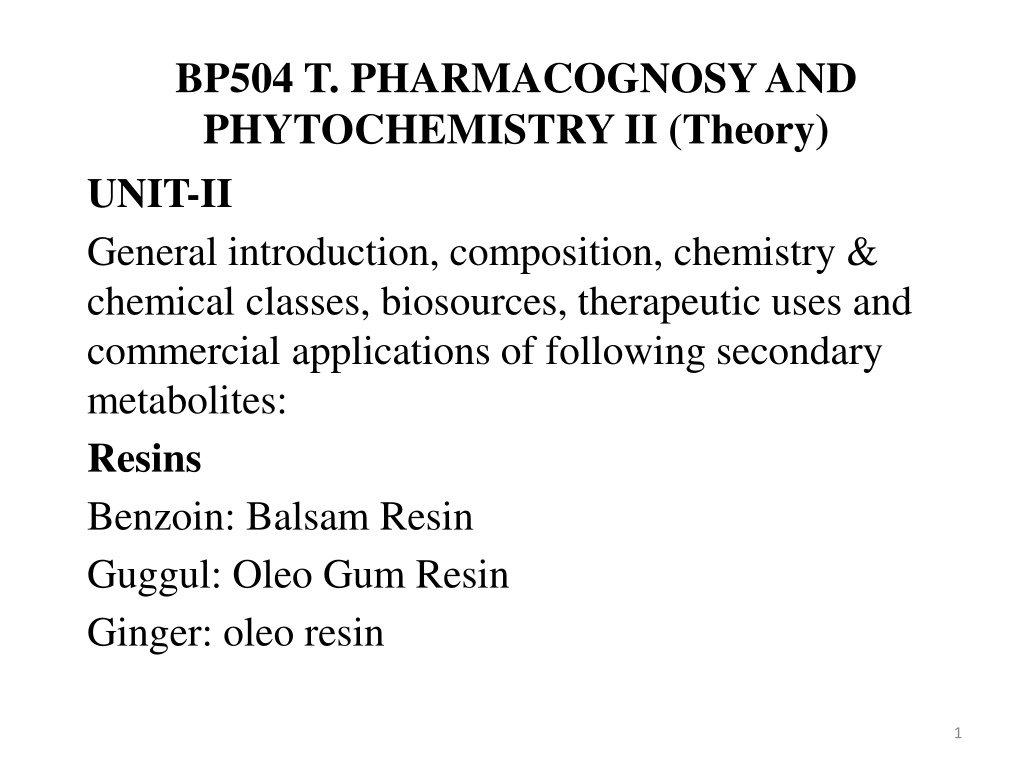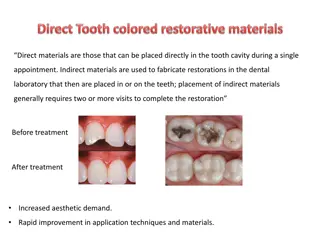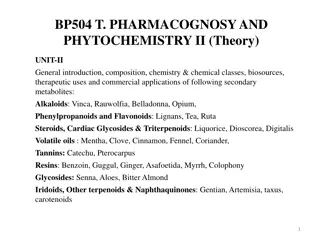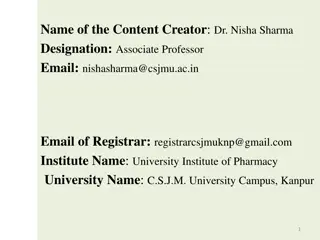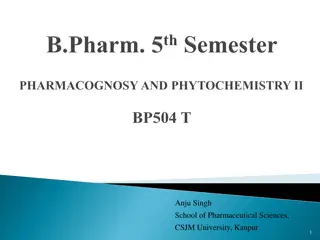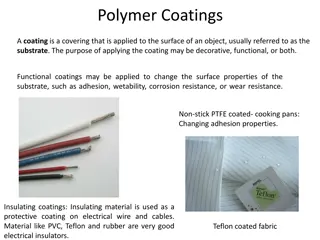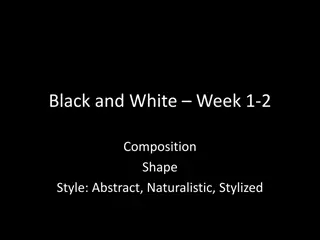Understanding Resins: Composition, Occurrence, and Classification
Resins are solid/semisolid amorphous products with complex chemical composition and are found in plants, animals, and fossils. They contain essential oils, terpene products, and carboxylic acids. Resins occur as a result of normal metabolism or in response to injury, forming physiological or pathological resins. They can be classified based on occurrence with other metabolites, such as oleo resin, gum resin, oleo gum resin, balsam resin, and glycoresins. The chemical nature of resins can be classified based on the predominant chemical constituent, such as resin acids. Understanding the types and sources of resins is essential in pharmacognosy and phytochemistry.
Download Presentation

Please find below an Image/Link to download the presentation.
The content on the website is provided AS IS for your information and personal use only. It may not be sold, licensed, or shared on other websites without obtaining consent from the author. Download presentation by click this link. If you encounter any issues during the download, it is possible that the publisher has removed the file from their server.
E N D
Presentation Transcript
BP504 T. PHARMACOGNOSY AND PHYTOCHEMISTRY II (Theory) UNIT-II General introduction, composition, chemistry & chemical classes, biosources, therapeutic uses and commercial applications of following secondary metabolites: Resins Benzoin: Balsam Resin Guggul: Oleo Gum Resin Ginger: oleo resin 1
RESINS Resins : Solid/semisolid amorphous products of complex chemical nature containing large number of C atom. These are mixture of essential oil, oxygenated products of terpenes & carboxylic acids. Source: Natural- found in Most of the plant parts or exudate of plant because of injury or incision made Ex: In plants: Asafoetida (Hing), Benzoin (lobaan), Ginger, Podophyllum, Capsicum etc From animals: Shellac (Lac), From Fossils ex: Copal Distributes mainly in Spermatophyta i.e. seed plants, sometimes in ferns (Pteridophyta) In higher plants- they are end products of their metabolites
RESINS Occurance: secreted in special form of structures (may be internally or surface) In Ginger: Resin cells, In cannabis- Glandular hair, In pine- Schizogenous or schizolysogenous ducts or cavities Schizogenous: developed by separation or splitting apart of cells, enclosing a cavity which then enlarges, lined by secretory epithelial cells, formed by the division of surrounding cells. Lysigenous: cavities in the bodies of plants form because of break down of certain cells. considered to originate from a single cell by the division in different directions forming a solid mass of secreting cells and then by the gradual disintegration or solution of the resulting cells starting from the center. Schizolysigenous: develops at first schizogenously but, then increases in size by the break down of the bounding cells producing secretion
CLASSIFICATION OF RESINS 1. Based on formation Physiological resin: Formed as normal product of metabolism Ex: cannabis, podophyllum, ginger Pathological resins: Formed as a result of wound, injury or abnormal circumstances: Ex: benzoin, asafoetida, guggul 2. On the basis of occurance with other secondary metabolites (Resin combination) i) Oleo resin : Naturally occuring mixture of resin & volatile oil ex: Ginger, capsicum, copaiba ii) Gum Resin: Resin associated with gum example: colophony, cannabis iii) Oleo Gum Resin: Mixture of volatile oil, Gum & resin Ex: Guggul, Asafoetida, Myrrh iv) Balsam Resin: Resinous mixture of benzoic acid/ cinnamic acid or esters of tehse acids in free or combined form Ex: Benzoin, Tolu balsam, peru balsam v) Glycoresins: occur in combination with sugar by Glycoside linkage Ex: Jalap, Podophyllum, Ipomoea
CLASSIFICATION OF RESINS 3) Depending upon the chemical nature pf predominent chemical constituent i) Resin acid (Resinolic acid) : Found in free or esterified form, Large proportion of oxy acids, soluble in alkali forming soap derivatized as Metallic salt forming Resinates, E: Abietic acid- Colophony, commiphoric acid- Myrrh, Ferulic acid- Asafoetida ii) Resin alcohol (Resinols): Complex alcohol of high mol. Weight, found in free or ester with balsamic acid or acid resin, gives ve test with FeCl3, Ex: Cannabinol- cannabis, Gingerol- Ginger, Nenzoresinol- Benzoin iii) Resin Phenol (Resinotannols): Contain phenolic group, high Mol. Wt. , Give color reaction with FeCl3, occur as free or ester Ex: Peruresinotannol- Balsam of peru
CLASSIFICATION OF RESINS 4) Resin ester: Ester is chief constituent- Ester of resinols/ resinoltannols with resin acid/ Balsamic acid Ex: Coniferyl benzoate, Benzyl benzoate- Benzoin, Cinnamyl cinnmate- Storax 5) Resones: Complex natural inert substances, don t undergo hydrolysis, don t form salt, no specific chemical properties Ex: Asaresenes- Asafoetida, 6) Glucoresin : combined with sugar by glycosylation & produce glucoresin. Can be hydrolysed to aglycon & glycon portions.
IDENTIFICATION TEST FOR RESIN 1. Benzoin: Benzoin + Ether shake Extract +H2SO4 sumatra benzoin deep brown color & siam benzoin (deep purple color) 2. Colophony : Drug + acetic anhydride + 1 drop of Conc. H2SO4 Purple color that rapidly changes to violet color 3. Myrrh: Triturate with solvent ether Filter Evaporate thin film violet color on contact with Br2 vapor Triturate with water Yellow emulsion 4. Podophyllum: Drug+ alcohol Macerate Filter Filtrate + strong copper acetate solution Brown ppt 5. Tolu balsam: Acidic to litmus Drug + FeCl3 Green color (Resinotannol)
BENZOIN Sumatra Benzoin, Loban. B S: balsamic resin obtained from Styrax benzoin Dry & or Styrax parallelo neurus & species of Styrax. In the market known as Sumatra Benzoin or it may also contain balsamic resin from Styrax tonkinesis & other species known as Siam Benzoin, family Styraceae. Contains not less than 25% of total balsamic acids, with reference to dry alcohol soluble matter GS: Sumatra benzoin- produced in South Eastern Asia, chiefly Sumatra. Siam benzoin is obtained from trees grown in Thailand & Vietnam. 9
Benzoin Benzoin trees not grown in India, imported from Indonesia. It is pathological resin & collected from 6 yrs old wild/cultivated trees, collected by making incisions near base of tree. Reported to contain neither secretory nor the resinous constituents, produced only after incising the plant. Initial produce is amorphous & yellow, not used in medicine. Next flow oozing out of plant, collected & utilized for medicinal purposes. This resinous material is allowed to solidify & sun dried. Single tree produces about 10 kg material 10
BENZOIN Description: Sumatra Benzoin Color-greyish-brown or grey. Odor-Aromatic & characteristic. Taste-Sweetish & slightly acrid. Occurs in form of lumps of varying sizes or tears. Tears are externally yellowish, milky white. Surface is uneven. When heated, fumes of benzoic & cinnamic acids are produced. Siam Benzoin: Color-Yellowish-brown to rusty-brown. Odor - Agreeable & vanilla-like. Taste - sweetish & slightly acrid. Occurs as hard & brittle masses. When heated, it is softened & becomes plastic. 11
Chemical Constituents: Benzoin Sumatra benzoin: contains free balsamic acids (benzoic and cinnamic acids) & their esters Triterpenoid acids-summa resinolic & sia resinolic acids Siam benzoin: Ester coniferyl benzoate (about 76%), contains styrol, vanillin & phenyl propyl cinnamate. Siam benzoin differs from Sumatra variety in that Siam contains insufficient cinnamic acid to give an odor of benzaldehyde, when warmed with KMnO4 sol. 12
Identification test: Benzoin 1. Alc. Sol. of benzoin + water milky white solution. 2. Heat small qty benzoin (TT) covering opening of test tube with a glass plate Cool. Examine the glass plate under microscope. The crystals of cinnamic acid observed. 3. 2.5 g benzoin + 10 ml ether + shake well pour 2 to 3 ml of extract porcelain dish + 2 to 3 drops H2SO4 Sumatra benzoin: Deep brown colour Siam benzoin: deep purplish red colour 4. 1g benzoin + 4 ml KMnO4+ warm benzaldehyde smell (Sumatra benzoin) 14
Uses of Benzoin Irritating expectorant, a carminative & diuretic. Also used externally as antiseptic & a protective Used in form of compound tincture of benzoin, & as an inhalation, in treatment of upper respiratory tract infection. Preferred to retard the rancidity of fats & oil in the preparation of benzoate lard. Industrially, used to fix the odor of incense, soaps, perfumes & several other cosmetics & to mask the taste of pharmaceutical preparations. 15
GINGER Zingiber, Zingiberis, Sunthi. B S: whole or cut, dried scrapped or unscrapped rhizomes of Zingiber officinale , family Zingiberaceae. contain not less than 0.8 % of total gingerols on dried basis. G S: native of S E Asia, cultivated in Caribbean islands, Africa, Australia, Mauritius, Jamaica, Taiwan & India. > 35% of world's production -India. 16
GINGER Cultivation & Collection: Approx, 25,000 hectares of land in India, production of about 25,000 tones of dry ginger annually. In Kerala, Assam, HP, Orissa, W B, Karnataka. Needs warm humid climate, heavy rainfall. at sea level, but thrives best at altitude of 1000 - 1500 m. If no sufficient rainfall is available, proper arrangements for irrigation are necessary 17
Ginger Cultivation Sandy or clay or red loamy soils , by sowing rhizomes-June Seed-rhizomes- cut into small pieces & with one living bud in each About 1200 - 1400 kg ginger seed-rhizomes- per hectare. It is soil exhausting crop, needs good qty of manures & fertilizers Superphosphate, ammonium sulphate & potash Harvesting 6 months, leaves become yellow. By digging rhizomes. Washed, dried , improves color, prevent further growth. Rhizomes are scrapped, dried & coated with inert calcium sulphate Yield of 1500 kg/ hectare of green ginger India ranks 1st among ginger producing countries of the world 18
Preparation of Dry Ginger Full grown ginger rhizomes, digged, washed, to remove earthy matter, kept in water for 6-8 hrs, subjected to remove cork by scrabing. After removal of cork, washed again & kept in 2.0% lime H2O for about 6 hrs., shifted to small closed rooms & spread uniformly, exposed to fumes of S for12 hrs., repeated 3 times Then taken to perforated galvenised cages of 50 75 cm size, further 3 vessels containing each 20%, 25% and 50% sol.of NaOH w/v are prepared. Vessels containing NaOH sol. heated to boil solution. 19
Preparation of Dry Ginger Cages containing ginger-dipped in each sol. in ascending order conc. for not more 5 minutes in each. Alkali treated rhizomes-passed in another vessels with 4.0% (w/v) citric acid sol, & kept for two hrs. The rhizomes are washed properly, kept on pavements to dry. Sun dry or in oven Dried ginger sent to market in suitable packing 20
Macroscopic Characters Color - Externally, buff color Odor-Agreeable, aromatic. Taste Agreeable, pungent. Size - Rhizomes of ginger are about 5-15 1.5-6.5 cm. Shape - laterally compressed, bearing short flat, ovate & oblique branches on the upper side, with bud at apex. Fracture Short & fibrous. Longitudinal striations & occasional projecting fibres present on surface Transversely cut surface shows well marked endodermis & stele. 21
Chemical Constituents Volatile oil (1 -4%), starch (40-60%), fat (10%), fibre (5 %), inorganic material (6%), residual moisture (10 %) & acrid resinous matter (5-8 %). Ginger oil: monoterpene hydrocarbons, sesquiterpene hydrocarbons, oxygenated mono and sesquiterpenes, & phenyl propanoids. Sesquiterpene hydrocarbon content of all types of ginger oil from different countries is almost same & includes -zingiberene, -bisabolene, -farnesene, - sesquiphellandrene & -curcumene. 22
Chemical Constituents Aroma & flavor-main characters of ginger. Aroma- due to fragrant principles of volatile oil Flavor, pungency & pharmacological action is exerted by phenolic ketones of oleo-resin. Components of volatile oil- isometric terpenic aldehydes ex. Geranial & citral, cause delicate, lemony aroma. Few sesquiterpene oil hydrocarbons- believed to exert spicy note. Phenolic ketones of oleo resin include gingerols like shogaols, zingerone, paradols, gingediols, hexahydrocurcumin & o-methyl ethers of these compounds. 23
Uses stomachic, an aromatic, carminative, stimulant & flavoring agent Ginger oil -in mouth washes, ginger beverages & liquors Ginger powder- effective in motion sickness. Adsorbent, aromatic & carminative properties of ginger on G. I. tract cause adsorption of toxins & acid enhanced gastric motility. May have probably blocking effects of G. I. reactions & nausea. Z. officinale (Methanolic extract)- molluscicidal effects, controls parasitic infection viz. schistosomiasis. U.S. FDA - included ginger-product generally regarded as safe (GRAS). Storage : coated with lime to improve its color, quality, hence known as limed ginger. Adulterants: exhausted ginger, detected by determination of water soluble ash, volatile oil content & alcohol & water soluble extractives. 24
Ginger Oleo Resin Gingerin Biological Source It is the oleo-resin obtained by percolating the powdered rhizomes of Zingiber officinale (Zingiberaceae). Method of Preparation: Coarsely powdered dried ginger is extracted with acetone or ethyl ether or ethylene dichloride by percolation method. The drug is extracted until exhausted and the extracts are mixed together. The solvent is removed by distillation under reduced pressure. Alcohol gives the maximum yield of oleo-resin. The yield of gingerin may vary from 3.5 to 9.0% depending upon the source of the material and the method of preparation. An average yield of oleo resin is 6.5%. 25
Ginger Oil Description: dark brown, aromatic & pungent viscous liquid Chem Const: Gingerin contains approx 18-35% V oil of ginger. contains pungent, & non-pungent principles of ginger. Fresh samples-gingerin-30% gingerol (the main pungent substance), shogaol, zingerone. Uses: Oleo-resin can be standardized, so prepared in industry for its desired use. Oleoresin of ginger mainly used as flavor for carbonated beverages in the spices & condiments. Indian export of ginger oleo-resin during 1996-97 was found to be Rs. 451 lakhs. 26
GUGGUL 28
Guggul Scented Bdellium, Gum guggul, Commiphora. B S: oleo-gum-resin obtained by making deep incisions at the basal part of stem bark of Commiphora weightii family Burseraceae, should contain not less than 1.0% & not more than 1.5% Guggulsterones (Z & E). Most noted drugs from Ayurveda & Unani system Its demand in therapeutics has Increased substantially G S: Native to Africa in arid zones -Ethiopia, Somalia, Kenya, Zaire & Zimbabwe. Grows widely in various subtropical regions. In India, in Rajasthan & Gujarat States. Ajmer & Jaisalmer districts of Rajasthan are prominent 29
Cultivation and Collection of Guggul Grows upto 2-3 mt. woody tree, shows spinescent branches on pale yellow to brownish stem. Has characteristic silvery & paper like bark peelings, bears compound leaves with ovate sub- sessile leaflets & are serrated with smooth upper surface. Sandy loam soil with more gypsum, a pH 7.5 9 Requires low land use soils Propagated by seeds & stem cuttings. Seeds- natural mode of propagation. 30
Cultivation of Guggul Seeds-collected from matured red berries in July- Sept. Raised through nursery beds, transplanted after 6 months. Vegetative propagation, 25-30 cm long stem cuttings-June or Oct-Nov. CIMAP -clone of guggul plant- Maru-Sudha % E and Z Guggulosterones. Oleo-gum-resin-collected-at least 5 yrs old plant, tapped from main stem with 7.5 cm D , deep circular incisions 31
Cultivation of Guggul Resin ducts occur only in bark portion near cambial layer Guggul oozes out as yellowish white aromatic latex like matter. Dose of 400 ml ethaphon (2 - chloro-ethyl phosphoric acid) 3 times a yr the secretion upto 22 times Thick branches- best grade of guggul. 0.5 -1kg of guggul/year/plant 32
Guggul Description Color - Brown to pale yellow or dull green. Odor - Agreeable, aromatic, balsamic. Taste - Characteristic bitter. Size - 0.5 to 2.5 cm in diameter. Shape -Rounded or irregular masses or agglomerated tears. Tears somewhat transparent, waxy surface, brittle in nature. Gummy touch & tears-normally with fractured surface. Solubility - When triturated with water, forms white emulsion. partly soluble in alcohol. 33
Guggul Chemical Constituents: The gum-resin portion of guggul -steroids, diterpenoids, carbohydrates, aliphatic esters. Are present in complex mixture form, but the resin does not contain free cinnamic acid, benzoic acid or their esters normally found in many oleo-gum-resin. Purified gum gives pentosan, pentose & furfural. Steam distillation gives pale yellow volatile oil, containing terpenes like myrcene, caryophylline. It contains Z , E guggulosterone & 3 new sterols viz. guggulosterol I, II and III. 34
Guggul Chemical Test: Ethyl acetate extract of guggal + acetic anhydride+ boil, cool + 2 ml H2SO4 green color at the junction due to sterols. Uses: used as anti-inflammatory, anti-rheumatic hypolipidemic & hypo-cholesteremic drug. Lowers low density lipoproteins & supports weight contact. 'Guggulip' developed from Commiphora mukul- antihyperlipidaemic product. Adulterants: adulterated with resins of various Commiphora species like C. abyssinica, C. roxburghii, C. molmol and also with Boswellia serrata. 36
Reference Pharmacognosy, C.K. Kokate, A.P. Purohit, S.B. Gokhale, 54th Ed. 2017, Nirali Publication, New Delhi 37
